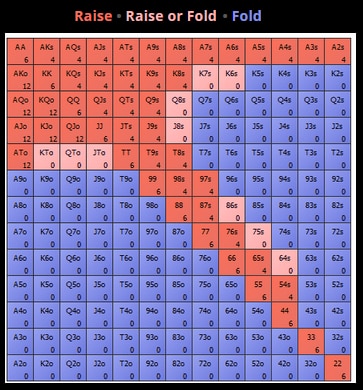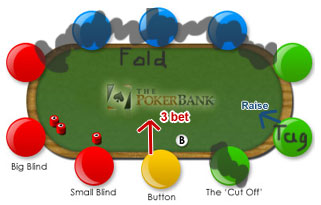Poker 3 Bet Definition
The Three Bet



The term “3bet” has a tendency to cause confusion, especially amongst newer players. It frequently happens that a new player will assume that a “3bet” is a raise roughly 3 times the size of the previous bet. It’s quite easy to see how this assumption arises. Let’s first consider the correct definition of “3bet”. Three betting is a necessity in most any game to one degree or another, but 3-bet folding can cost you a lot of money. There are certain situations where it will drain your bankroll and other spots where it is the only reasonable play. As is the case with most any play in poker, there are a number of variables that you will need to take into consideration.
- The three-bet light is an online poker term that is used to describe three-betting with non-premium hands as a form of bluff to get folds from better hands. Three betting “light” with a wider range of hands then you would normally is a skill you will have to get used to especially as you begin to progress through the various stakes online and live.
- All About 3 Betting in Poker The Three Bet. One of the common definitions you will hear as you play poker is “3-bet”, or “three-bet”. A 3-bet as most players use the term means the act of putting in the third bet, technically the second “raise”, the “3-bet” during any given round of action. It’s only in recent years that the term has become popular, indicative of its use during online play.
One of the common definitions you will hear as you play poker is “3-bet”, or “three-bet”. A 3-bet as most players use the term means the act of putting in the third bet, technically the second “raise”, the “3-bet” during any given round of action. It’s only in recent years that the term has become popular, indicative of its use during online play.
For flop games, such as hold’em and Omaha, the pre-flop 3-bet is technically different than the post-flop 3-bet. In these poker games blinds are used, and the act of posting the small and big blinds is considered the first “bet”. Subsequent players, beginning with the “under the gun” (UTG) player to the big blind’s immediate left, have the option of calling that first bet (the amount of the big blind), or folding or raising. In a typical game, the first pre-flop raise is technically a “two-bet”, but you’ll never hear it called that. Instead, it’s when another play makes a second raise, going over the top of the first raiser, that the “three-bet” term is used. Below is a visual of what a pre-flop 3-bet looks like.
In post-flop play, the 3-bet consists of an initial bet, a raise, and then a re-raise (perhaps by the initial bettor). Since the initial bet itself can be sizable, the post-flop 3-bet is proportionately larger in most instances than its pre-flop counterpart. In cash games and in the late stages of tourneys, 3-bets often involve all-in moves by one or more players, though you’re just as likely to hear the words “pushing” or “jamming” (moving one’s entire stack into the middle) in those instances.
What Does a 3-Bet Mean?
A 3-bet, which is always a form of a re-raise is designed to be an indicator of a true premium hand. The 3-bet is a shot over the bow of the initial raiser, designed to capture that pot right there. The intent of the 3-bet is to say to the initial bettor, “Yeah, you may have a good hand, but I’ve got a better one.” One common variation involves the initial raise coming from a late position, the button player or the cut-off (to the button’s immediate right), and the 3-bet is made by the small or big blind, who may assume the button or cutoff is attempting to steal the blinds. Overall, the 3-bet is traditionally one of the strongest moves a player can make, trailing perhaps only the all-in push and the check-raise in its ability to change a hand. It’s supposed to mean that the player making the move has a very strong hand, though this being poker, that is not always the case.
Making Your Own 3-Bets
The use of 3-bets is best done selectively, at opportune moments. Many hyper-aggressive players 3-bet with a wide range of hands, including many garbage hands, in the nature of bluffs. Most 3-bets, however, are done with big hands.
When to 3-bet a hand and when to just call (called a “smooth call” or “smoothing”) is one of the trickiest lessons players must learn. Knowing your opponents’ tendencies is vital to success, because the best poker players play their opponents as much as their own hands. A 3-bet works best against fairly loose players, some of whom are described as “calling stations”, who simply cannot fold marginal holdings when prompted. Another successful type of 3-bet can be done against a player who might over-value the long-term prospects of the game or tourney in deference to what might happen in that specific hand. He might be surrendering a bit too much of his chance to win in hopes of getting a better opportunity in a later hand.
Then there are bluffs. The bluff type of 3-bet is called a “re-steal”, and properly executed, it can be one of the most profitable moves in a player’s arsenal. However, like any good play, using it too much is one of the quickest ways to go broke. Other players will eventually react to a player that is putting in too many 3-bets, and sooner or later, the player putting in those over-the-top bets will be “looked up” (called) by his opponent. However, if you’re a steady, conservative player, 3-betting an aggressive foe will work more often than you might believe. Those players are trying to steadily make small gains against your perceived, relative passivity, and when you fight back they’ll often go try another door.

Poker 3 Bet Definition Math
Defending Against the 3-Bet
Defending against the 3-bet boils down to understanding both your opponents and the circumstances of the game. Against a tight opponent who plays few hands, a 3-bet invariably means a monster and you can ditch all but the largest hands against this opponent. Even if he’s on a rare bluff, his natural tendencies against bluffing should serve as a warning.
Poker 3 Bet Definition Synonyms
Aggressive, late-position players will often three-bet with holdings such as middle pairs, AK or AQ, and depending on your own hand, it’s often correct to play or even to put the 4-bet in and take your chances. Be aware that with position and with correct “pot odds” – referring to the relationship between the amount of money already in the pot and the total amount a player stands to win – a late-position player may be “priced in” to making his own call with more inferior hands than you might hope.

Poker 3 Bet Definition
Author:Joseph Falchetti (twitter)
(C) Copyright PokerWebsites.com, 2018